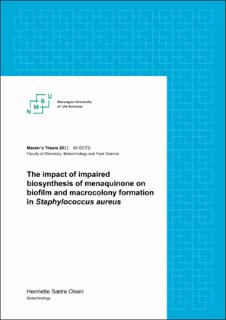| dc.contributor.advisor | Kjos, Morten | |
| dc.contributor.advisor | Shapaval, Volha | |
| dc.contributor.author | Olsen, Henriette Sætre | |
| dc.date.accessioned | 2021-11-01T12:03:50Z | |
| dc.date.available | 2021-11-01T12:03:50Z | |
| dc.date.issued | 2021 | |
| dc.identifier.uri | https://hdl.handle.net/11250/2826855 | |
| dc.description.abstract | Staphylococcus aureus (S. aureus) is known to cause biofilm-associated infections in humans. Biofilms are surface associated microbial communities and is characterized as three-dimensional structures with cells embedded in a self-produced extracellular matrix. Due to the protective nature of biofilms, these infections are difficult to eradicate and often become chronic. Biofilms are often resistant or less susceptible to host immune agents or antibiotics, therefore it is of great interest to find alternative treatment methods. In order to find potential treatments, it is important to study the biofilm formation of these bacteria to better understand the underlying regulations and effects that determine how the final biofilm structure and composition is determined. Among other things, respirational processes have been shown to influence the biofilm formation. Specifically, molecules involved in electron transport are therefore critical for biofilm formation and potential targets for anti-biofilm compounds. In this work, we have therefore studied several depletion, deletion and complementation mutants of S. aureus genes involved in synthesis of menaquinone, and important electron carrier during respiration in S. aureus, in order to explore how this affects the biofilm structure and composition.
Initially, we show that biofilm macrocolonies of S. aureus strains harbouring deletions of genes involved in menaquinone synthesis display altered morphological characteristics when grown in aerobic environments. Deletion of ubiE, encoding the last enzyme in the menaquinone biosynthesis pathway, resulted in biofilm macrocolonies with lack of structures (e.g. wrinkling) which was observed for the wild-type grown under the same conditions, as well as reduced biofilm formation on abiotic surfaces. Upon complementation of the ubiE mutant, the wrinkling phenotype was restored. CRISPR interference depletion strains targeting other genes in the menaquinone synthesis did also reveal phenotypic changes in macrocolonies for menA. Interestingly, lack of structuring of the biofilm was also observed for the cell when grown anaerobically, demonstrating that loss of structures most probably was a result of altered metabolism in the mutants. Further analysis of the extracellular matrix (ECM) of the biofilms using FTIR spectroscopy and direct quantification of ECM extracts showed large differences in the chemical composition of the macrocolony ECMs (including differences in quantity and compositions of proteins, eDNA and possibly polysaccharides, both between knockout mutants and wild-type, and between strain grown aerobically and anaerobically). Together, this can tell us that genes that participates in the synthesis of menaquinone have an impact on the final chemical composition of S. aureus biofilms. | en_US |
| dc.description.abstract | Staphylococcus aureus (S. aureus) er kjent for å forårsake biofilmassosierte infeksjoner hos mennesker. Biofilmer er overflateassosierte mikrobielle samfunn og er karakterisert som tredimensjonale strukturer med celler innkapslet i en egenproduser ekstracellulær matriks. På grunn av biofilmens beskyttende natur er disse infeksjonene vanskelige å bekjempe og blir ofte kroniske. Biofilm er ofte resistent eller mindre mottakelig for vertens immunsystem eller antibiotika, og det er derfor av stor interesse å finne alternative behandlingsmetoder. For å finne mulige behandlinger er det avgjørende å vite hvordan biofilmdannelsen skjer hos disse bakteriene, og forstå de underliggende regulatoriske effektene som bestemmer hvordan den endelige biofilmstrukturen og sammensetningen er. Blant annet har respiratoriske prosesser vist seg å ha en effekt på biofilmdannelsen. Molekyler involvert i elektrontransporten er derfor kritiske for dannelsen av biofilm og mulige mål for anti-biofilmforbindelser. I dette arbeidet har vi derfor studert flere delesjons-, deplesjons- og komplementerings-mutanter av S. aureus gener involvert i syntesen av menaquinone, en viktig elektronbærer under respirasjonen i S. aureus, for å utforske hvordan dette påvirker biofilm strukturen og sammensetningen.
Innledningsvis viser vi at biofilm makrokolonier av S. aureus stammer som bærer delesjoner av gener involvert i menaquinone syntesen viser endrede morfologiske egenskaper når de dyrkes i aerobe omgivelser. Fjerning av ubiE, som koder for det siste enzymet i biosynteseveien til menaquinone, resulterte i biofilmmakrokolonier med manglende strukturer (eks. rynker) som ble observert for villtypen dyrket under samme forhold, samt redusert biofilmdannelse på abiotiske overflater. Ved komplementering av ubiE-mutanten ble den strukturelle fenotypen gjenopprettet. CRISPR interferens deplesjonsstammer av andre gener i menaquinone syntesen viste også fenotypiske endringer hos makrokolonier for genet menA. Interessant nok, ble det også observert mangel på biofilm strukturering for celler som vokste anaerobt, noe som demonstrerer at tap av strukturer sannsynligvis var et resultat av endret metabolisme i mutantene. Videre analyse av den ekstracellulære matriksen (ECM) til biofilmene ved bruk av FTIR-spektroskopi og direkte kvantifisering av ECM-ekstrakter viste store forskjeller i den kjemiske sammensetningen av ECM fra makrokolonier (inkludert forskjeller i mengde og sammensetning av proteiner, eDNA og antakelig polysakkarider, både mellom delesjonsmutanter og villtype og mellom stammer dyrket aerobt og anaerobt. Samlet kan dette fortelle oss at gener som deltar i syntesen av menaquinone har innvirkning på den endelige kjemiske sammensetningen av S. aureus biofilmer. | en_US |
| dc.language.iso | eng | en_US |
| dc.publisher | Norwegian University of Life Sciences, Ås | en_US |
| dc.rights | Attribution-NonCommercial-NoDerivatives 4.0 Internasjonal | * |
| dc.rights.uri | http://creativecommons.org/licenses/by-nc-nd/4.0/deed.no | * |
| dc.title | The impact of impaired biosynthesis of menaquinone on biofilm and macrocolony formation in Staphylococcus aureus | en_US |
| dc.type | Master thesis | en_US |
| dc.description.localcode | M-BIOTEK | en_US |

